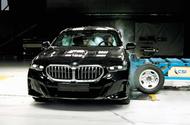It costs around £400,000 to assess a new model for safety
Leading crash safety firm tested 55 fewer models in 2023 compared with 2022 as a result of challenging new tests
Euro NCAP has blamed a significant reduction in the number of cars that it evaluated last year partly on manufacturers rushing to beat the introduction of tougher tests.
The European vehicle safety testing agency, whose five-star safety rating is keenly sought by manufacturers the world over, rated 73 cars in 2022, making it the organisation’s busiest year ever.
However, in 2023, it rated just 18 cars. Explaining the reduction, a Euro NCAP spokesman said: “Manufacturers were eager to get their cars rated in 2022, demonstrating that they met the original design targets, before the rating scheme changed in 2023 with the introduction of new, challenging test scenarios.”
Such is the power of Euro NCAP’s rating system to influence not only how well a new car sells but also the insurance group it occupies that, claimed the organisation, new test scenarios now define product cycles and launch dates, with car makers establishing at the outset what their target star rating is against which version of the protocols.
Having decided this, there is, it said, pressure on them to put the car into production in time to meet those targets. Euro NCAP added that for this reason it was unsurprised by the reduction in ratings that it awarded in 2023.
The spokesman said: “It isn’t uncommon that manufacturers need a bit more time to understand what requirements must be met for five stars. We have seen these fluctuations [in our testing numbers] occur over the last decade.”
However, changes to the tests weren’t the only reason why fewer cars were rated in 2023. Manufacturers are in a process of transition, extending the life of some long-running, combustion-engined cars while giving themselves breathing space to continue their work developing all-new electric cars.
As a result, and especially in recent years, Euro NCAP has rated a lot of powertrain variants of ICE models – a trend that is beginning to slow as new electric cars come on stream.
Additionally, the difference in the number of cars that Euro NCAP rated in 2022 compared with 2023 was amplified not only by car makers rushing to beat the introduction of new test protocols but also by the Covid pandemic, which caused chip shortages and created a backlog of new model launches.
The spokesman said: “The test requirements for 2022 had been in place since January 2020 – one year longer than was originally planned, due to the impact of the pandemic. Many manufacturers were forced to postpone new car introductions and were plagued by the chip shortages, causing cuts in production volumes and delays.”
With the pandemic now a distant memory and its new tests established, Euro NCAP expects to rate at least 40 cars in 2024 and possibly more in 2025 ahead of the introduction of further new tests in 2026.







